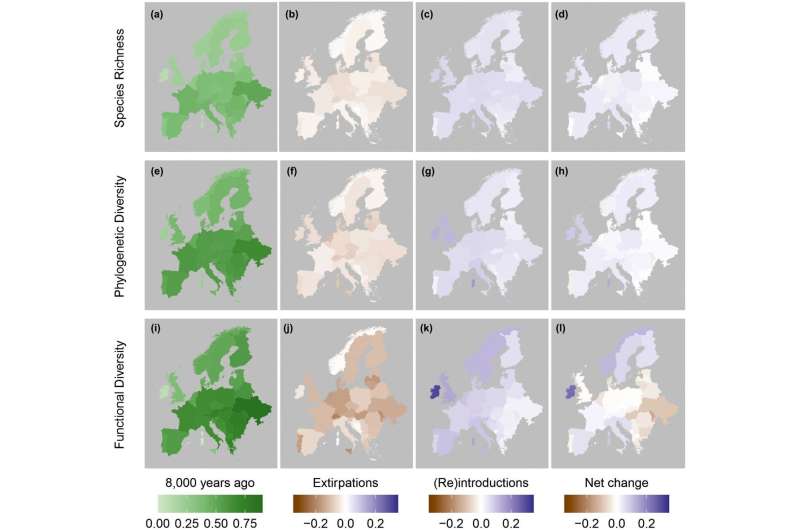Biodiversity of Europe's mammals as rich as it was 8,000 years ago, according to new research

A new study comparing the biodiversity of wild mammals in Europe 8,000 years ago with the present has found that more species have been gained than lost on the continent.
The study, published in Global Change Biology and led by the University of York, found that recent species recovery and the introduction of non-native species has increased diversity by equivalent or greater amounts in many European regions, despite loss of habitat and local extinctions in many areas.
If the current momentum for conservation and rewilding projects continues, alongside projects to reintroduce mammals once driven from Europe's rivers, forests and mountains—such as wolves, beavers and lynx—there is the potential to increase diversity beyond the levels seen 8,000 years ago in most regions, the researchers say.
While some island mammals are now extinct, only two species that roamed the mainland 8,000 years ago have been permanently lost globally—the Aurochs (a wild ancestor of the cow) and the European Wild Ass.
Dr. Jack Hatfield from the Leverhulme Center for Anthropocene Biodiversity at the University of York, said, "Although our study does not look at gains and losses in numbers of animals within species, it offers a hopeful vision for the future. The great majority of Europe's mammals are still here and if promises to give more land over to nature are upheld, biodiversity levels could increase beyond the levels seen by our ancestors.|
"Many studies have shown large declines in some populations so it is surprising how well nature can adapt to anthropogenic changes at a regional scale. The success of conservation actions like reintroduction programs such as beavers and bison being brought back to many European countries, along with the movement of non-native species around Europe have also served to maintain biodiversity levels."
Co-author of the study, Professor Chris Thomas, Director of the Leverhulme Center for Anthropocene Biodiversity, added, "while it is not possible to return the natural environment to the way it was 8,000 years ago, not all change is bad and our study highlights the possibility of a positive future for our relationship with Europe's mammals."
The study compared present day data with data from archaeological records identifying the presence of mammals 8,000 years ago, when there were only an estimated five million people on the planet and early farming was spreading across Europe.
The researchers chose this time period as a point of comparison as the climate had recently become more stable, making it easier to distinguish between man-made impacts on species and naturally occurring changes. Species such as the Wooly Rhino and Mammoth had already disappeared at the end of the last ice age.
The researchers caution that while their study paints a hopeful picture for Europe's mammals, the same may not be true in other parts of the world where rapid habitat destruction is taking place.
More information: Jack H. Hatfield et al, Lost, gained, and regained functional and phylogenetic diversity of European mammals since 8000 years ago, Global Change Biology (2022). DOI: 10.1111/gcb.16316
Journal information: Global Change Biology
Provided by University of York

















